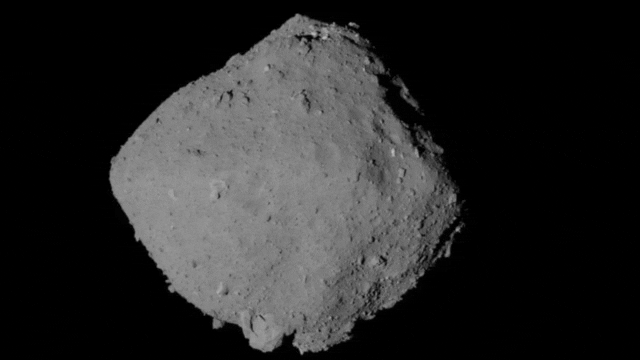Boulders on asteroid Ryugu are surprisingly fluffy, Japan's Hayabusa2 probe finds
The rocks are about as porous as the building blocks of planets.

Boulders on asteroids can be three-quarters hollow or more, a discovery that could help yield insights on the way in which Earth and other planets formed, a new study finds.
The earliest stage of planetary formation started with building blocks known as planetesimals, chunks of rock ranging in size from asteroids to dwarf planets. Previous research suggested planetesimals might have begun as very porous, fluffy clumps of dust that heat, gravity and impacts compacted over time. But this idea remains unproven, study lead author Naoya Sakatani, a planetary scientist at Rikkyo University in Japan, told Space.com.
Recently, Japan's Hayabusa2 spacecraft discovered that Ryugu, a diamond-shaped 2,790-foot-wide (850 meters) near-Earth asteroid, is covered with rocks that are about 30% to 50% porous. Now Sakatani and his colleagues have found that those boulders may be more than 70% empty space, or about as porous as prior work suggested ancient planetesimals were, suggesting the rocks may contain remnants of the early solar system.
Related: Samples of asteroid Ryugu arrive in Japan after successful Hayabusa2 capsule landing
The researchers used Hayabusa2's thermal infrared camera to analyze Ryugu's surface and discovered two isolated hotspots. The spacecraft's telescope captured high-resolution images from one of them, revealing it possessed a cluster of boulders located near the center of a crater about 30 feet (9 m) wide.
The more porous areas on Ryugu are, the less matter they have and the easier they are to heat. Based on the heat from these hotspots, the scientists estimated the cluster of boulders in that first hotspot were 72% to 91% porous. Although they could not confirm whether the other hotspot had boulders, the heat they detected suggested the rock there was about 71% porous.
The researchers noted that Ryugu's hotspot boulders are about as porous as the bodies of comets. Prior work noted that comets are likely remnants of the original planetesimals, and Sakatani and his colleagues suggested that Ryugu's hotspot boulders may similarly be remnants of ancient planetesimals, which cosmic impacts blasted out from under Ryugu's surface.
Sign up for the Live Science daily newsletter now
Get the world’s most fascinating discoveries delivered straight to your inbox.
One possible origin for these extremely porous boulders is that they formed after cosmic impacts. However, Hayabusa2 had fired a cannonball at Ryugu and did not see any similarly porous boulders appear in the aftermath of that artificial impact, suggesting the porous boulders on the asteroid did not arise from collisions.
Related: Strange bright rocks reveal glimpse of asteroid Ryugu's violent past
Uncovering details about the original nature of planetesimals could shed light on how the planets formed. For example, the scientists previously noted that if planetesimals are as fluffy as researchers increasingly suspect, then they might have crumbled more easily during impacts, making them less likely to eject fragments with great force to shatter other asteroids.
In 2019, Hayabusa2 captured samples from Ryugu's surface and successfully returned these specimens to Earth in December 2020. Bits of highly porous and likely extraordinarily ancient rock may be included within these samples, potentially helping reveal more about the nature of the solar system's building blocks. However, analyzing this rock will prove difficult "because of its fragile properties," Sakatani said.
The scientists detailed their findings online May 24 in the journal Nature Astronomy.
Follow Charles Q. Choi on Twitter @cqchoi. Follow us on Twitter @Spacedotcom and on Facebook.

Most Popular


